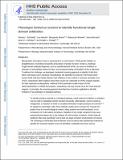| dc.contributor.author | Schmidt, Florian I. | |
| dc.contributor.author | Hanke, Leo | |
| dc.contributor.author | Morin, Benjamin | |
| dc.contributor.author | Brewer, Rebeccah | |
| dc.contributor.author | Brusic, Vesna | |
| dc.contributor.author | Whelan, Sean P.J. | |
| dc.contributor.author | Ploegh, Hidde | |
| dc.date.accessioned | 2017-04-28T15:28:51Z | |
| dc.date.available | 2017-04-28T15:28:51Z | |
| dc.date.issued | 2016-06 | |
| dc.date.submitted | 2016-01 | |
| dc.identifier.issn | 2058-5276 | |
| dc.identifier.uri | http://hdl.handle.net/1721.1/108492 | |
| dc.description.abstract | Manipulation of proteins is key in assessing their in vivo function. Although genetic ablation is straightforward, reversible and specific perturbation of protein function remains a challenge. Single domain antibody fragments, such as camelid-derived VHHs, can serve as inhibitors or activators of intracellular protein function, but functional testing of identified VHHs is laborious. To address this challenge, we have developed a lentiviral screening approach to identify VHHs that elicit a phenotype when expressed intracellularly. We identified 19 antiviral VHHs that protect human A549 cells from lethal infection with influenza A virus (IAV) or vesicular stomatitis virus (VSV), respectively. Both negative-sense RNA viruses are vulnerable to VHHs uniquely specific for their respective nucleoproteins. Antiviral VHHs prevented nuclear import of viral ribonucleoproteins or mRNA transcription, respectively, and may provide clues for novel antiviral reagents. In principle, the screening approach described here should be applicable to identify inhibitors of any pathogen or biological pathway.
To identify the proteins essential to a biological pathway, small-molecule inhibitors or activators may be used to manipulate protein function transiently. Alternatively, screens involving mutagenesis, a reduction in levels or complete elimination of gene products are common. As applied to mammalian cells, these methods usually seek to achieve the removal of a protein from its normal biological context. Many proteins are multifunctional, or are components of multi-subunit complexes. Depletion of any single component may cause unexpected phenotypes due to the collapse of entire protein complexes. Small-molecule inhibitors often lack specificity and at best can target a fraction of all the proteins of interest. The screening of chemically diverse libraries must be paired with sophisticated methods to identify the molecular targets of any hit identified. Antibodies have been used as intracellular perturbants of protein function after microinjection or cytosolic expression of single-chain variable antibody fragments, but technical challenges have limited their application to few selected cases.
In addition to conventional antibodies, the immune system of camelids generates heavy-chain-only antibodies. Their antigen binding site only consists of the variable domain of the heavy chain. This domain can be expressed on its own and is referred to as a VHH or nanobody, an entity that can retain its function in the reducing environment of the cytosol, independent of glycosylation. Many VHHs bind to their targets with affinities comparable to conventional antibodies. VHHs expressed in the cytosol can therefore act as molecular perturbants by occluding the interfaces involved in protein–protein interactions, by binding in the active sites of enzymes, or through the recognition or stabilization of distinct conformations of their targets. Both phage and yeast display, as well as mass spectrometry in combination with high-throughput sequencing, allow the identification of VHHs based on their binding properties. However, the identification of inhibitory VHHs remains a time-consuming process. VHHs obtained through biochemical screening methods must be expressed individually in the relevant cell type to test for the functional consequences of VHH expression. To address this challenge, we developed a phenotypic VHH screening method in living cells. | en_US |
| dc.description.sponsorship | National Institutes of Health (U.S.) (Health Pioneer Award) | en_US |
| dc.language.iso | en_US | |
| dc.publisher | Nature Publishing Group | en_US |
| dc.relation.isversionof | http://dx.doi.org/10.1038/nmicrobiol.2016.80 | en_US |
| dc.rights | Creative Commons Attribution-Noncommercial-Share Alike | en_US |
| dc.rights.uri | http://creativecommons.org/licenses/by-nc-sa/4.0/ | en_US |
| dc.source | PMC | en_US |
| dc.title | Phenotypic lentivirus screens to identify functional single domain antibodies | en_US |
| dc.type | Article | en_US |
| dc.identifier.citation | Schmidt, Florian I. et al. “Phenotypic Lentivirus Screens to Identify Functional Single Domain Antibodies.” Nature Microbiology 1.8 (2016): 16080. | en_US |
| dc.contributor.department | Massachusetts Institute of Technology. Department of Biology | en_US |
| dc.contributor.department | Whitehead Institute for Biomedical Research | en_US |
| dc.contributor.mitauthor | Ploegh, Hidde | |
| dc.relation.journal | Nature Microbiology | en_US |
| dc.eprint.version | Author's final manuscript | en_US |
| dc.type.uri | http://purl.org/eprint/type/JournalArticle | en_US |
| eprint.status | http://purl.org/eprint/status/PeerReviewed | en_US |
| dspace.orderedauthors | Schmidt, Florian I.; Hanke, Leo; Morin, Benjamin; Brewer, Rebeccah; Brusic, Vesna; Whelan, Sean P.J.; Ploegh, Hidde L. | en_US |
| dspace.embargo.terms | N | en_US |
| dc.identifier.orcid | https://orcid.org/0000-0002-1090-6071 | |
| mit.license | PUBLISHER_POLICY | en_US |
